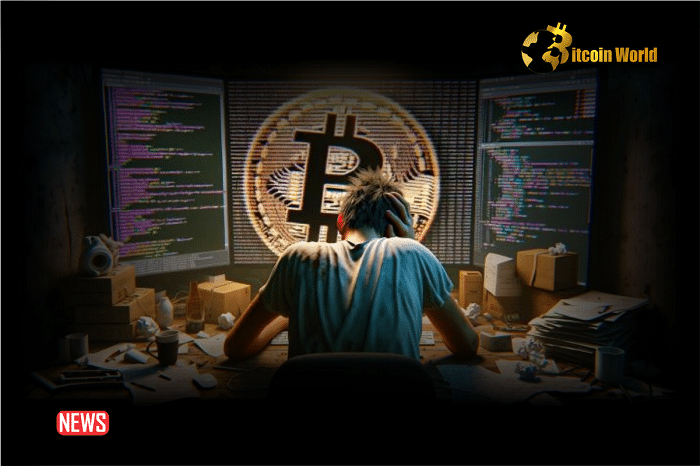Remember the early days of crypto when meme coins were all the rage, especially on Bitcoin? Well, the Bitcoin blockchain is buzzing again, thanks to Bitcoin Ordinals and BRC-20 tokens! This new wave of activity has sparked something really important: Bitcoin developers are joining forces to officially define the rules for BRC-20 tokens. Think of it as bringing order to the exciting, sometimes chaotic, world of Bitcoin-based tokens.
Why Formalize BRC-20? The Need for Guidelines
The explosion of Bitcoin Ordinals, which let you inscribe data onto individual satoshis (the smallest unit of Bitcoin), paved the way for BRC-20 tokens. These tokens, built on top of Bitcoin, have become incredibly popular, especially for creating meme coins and experimenting with new functionalities. But with rapid growth comes the need for structure. That’s where the Layer 1 Foundation steps in.
- BRC-20 tokens have taken Bitcoin by storm, enabling new types of assets and applications.
- The rapid growth highlighted the need for clear, formal guidelines to ensure stability and trust.
- A coalition of Bitcoin developers formed the Layer 1 Foundation to address this need.
This newly formed foundation isn’t about controlling innovation; it’s about creating a stable and transparent environment for BRC-20 to flourish. They’ve announced a governance body dedicated to ensuring trust in the protocol, which they see as essential for the future of BRC-20 and Bitcoin Ordinals.
Isabel Foxen Duke, Vice President of the Layer 1 Foundation, put it plainly: “We invited all of the biggest BRC-20 indexers to become partners… and to publicly agree to operate within this particular standard of procedure and governance resolution that we wrote and set forth as operating principles for BRC-20 governance.” You can check out their resolution here.
See Also: Donald Trump Says He “Sometimes Will Let People Pay Through Bitcoin”
Who’s Behind the Layer 1 Foundation? Key Players in BRC-20 Governance
This isn’t just a random group; it’s a collaboration of some of the most influential players in the BRC-20 space. The Layer 1 Foundation was co-founded by Domo, the pseudonymous creator of BRC-20 itself! That’s a strong endorsement right there. Other key participants include:
- Hiro: Known for building developer tools for Bitcoin.
- Alex Labs: Focusing on bringing DeFi to Bitcoin.
- Oyl Dynamics: Involved in Bitcoin infrastructure and solutions.
- Allium Labs: Building tools and services around Bitcoin Ordinals.
- UTXO Management: Experts in Bitcoin transaction management.
Furthermore, two major players in the BRC-20 ecosystem, Unisat (a popular Bitcoin wallet developer) and Best in Slot (an Ordinals aggregator), will jointly lead the ongoing maintenance of the BRC-20 protocol. This collaborative approach signals a commitment to shared responsibility and future development.
The Core Principles: Simplicity, Safety, and Community
So, what exactly are the principles guiding the Layer 1 Foundation? Their resolution outlines several key goals, all aimed at fostering a healthy and sustainable BRC-20 ecosystem:
- Simplicity in Technical Architecture: Keeping things straightforward to reduce complexity and potential vulnerabilities.
- Safety-First Approach: Prioritizing security and thorough testing when making any changes to the protocol or its indexers.
- Fostering Mutual Discussions: Encouraging open communication and collaboration among developers and the community.
- Considering the Community: Taking community feedback into account when making development decisions.
- Open-Source Protocol Changes: Ensuring transparency by making all protocol-level changes publicly accessible.
By publicly committing to these principles, the Layer 1 Foundation hopes to prevent future disagreements and potential disruptions, like the hard fork threat that loomed earlier this year.
Avoiding Hard Forks: A Unified Path Forward
Remember the talk of a hard fork? Let’s quickly break down what that means. A hard fork is a significant change to a blockchain that isn’t compatible with older versions. It essentially splits the blockchain into two, requiring everyone to upgrade to the new version to stay on the main network. Imagine updating your phone’s operating system, but if you don’t, you can no longer use certain apps or communicate with others who have updated.
Earlier in January, a disagreement arose within the BRC-20 community regarding the Jubilee update to Bitcoin Ordinals. Domo raised concerns that this update could impact how BRC-20 tokens are indexed, leading to a split in opinions, particularly between Unisat and Domo. Domo advocated for thorough testing due to safety concerns, while others had different perspectives.
However, Lorenzo, the founder of Unisat Wallet, clarified that forking BRC-20 was not their intention, even amidst the debate. This sentiment, combined with the formation of the Layer 1 Foundation, indicates a strong desire within the community to work together rather than fracture.
See Also: London Stock Exchange (LSE) To Accept Bitcoin Exchange-traded Notes (ETNs) Applications
Putting Users First: Decentralized Governance for the BRC-20 Community
Foxen Duke emphasizes that the ultimate goal is to protect BRC-20 users and prioritize their needs above any single developer’s agenda. This is a crucial point. By establishing a decentralized governance structure, the Layer 1 Foundation aims to ensure that no single entity has excessive control over the future of BRC-20.
“We’re advocating for real people who hold value in this protocol and being a voice for them,” Foxen Duke stated. This user-centric approach is vital for the long-term health and growth of the BRC-20 ecosystem.
Decentralizing governance means distributing decision-making power across multiple stakeholders, preventing any one company from wielding disproportionate influence that could benefit them at the expense of the community. This move towards formalized governance is a significant step in the maturation of BRC-20 and its integration within the broader Bitcoin ecosystem.
Disclaimer: The information provided is not trading advice. Bitcoinworld.co.in holds no liability for any investments made based on the information provided on this page. We strongly recommend independent research and/or consultation with a qualified professional before making any investment decisions.
#Binance #WRITE2EARN
Disclaimer: The information provided is not trading advice, Bitcoinworld.co.in holds no liability for any investments made based on the information provided on this page. We strongly recommend independent research and/or consultation with a qualified professional before making any investment decisions.


